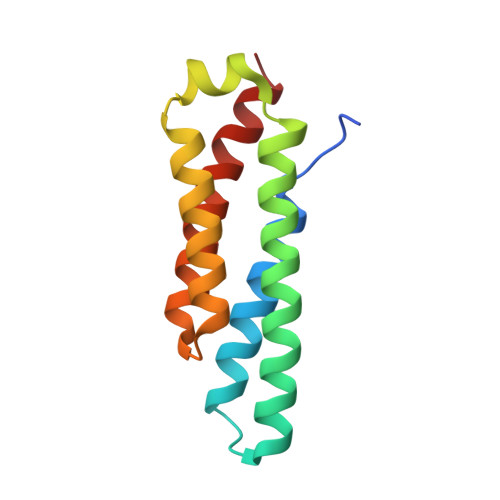Nickel superoxide dismutase: structural and functional roles of His1 and its H-bonding network.
Ryan, K.C., Guce, A.I., Johnson, O.E., Brunold, T.C., Cabelli, D.E., Garman, S.C., Maroney, M.J.(2015) Biochemistry 54: 1016-1027
- PubMed: 25580509
- DOI: https://doi.org/10.1021/bi501258u
- Primary Citation of Related Structures:
4NCQ - PubMed Abstract:
Crystal structures of nickel-dependent superoxide dismutases (NiSODs) reveal the presence of a H-bonding network formed between the NH group of the apical imidazole ligand from His1 and the Glu17 carboxylate from a neighboring subunit in the hexameric enzyme. This interaction is supported by another intrasubunit H-bond between Glu17 and Arg47. In this study, four mutant NiSOD proteins were produced to experimentally evaluate the roles of this H-bonding network and compare the results with prior predictions from density functional theory calculations. The X-ray crystal structure of H1A-NiSOD, which lacks the apical ligand entirely, reveals that in the absence of the Glu17-His1 H-bond, the active site is disordered. Characterization of this variant using X-ray absorption spectroscopy (XAS) shows that Ni(II) is bound in the expected N2S2 planar coordination site. Despite these structural perturbations, the H1A-NiSOD variant retains 4% of wild-type (WT) NiSOD activity. Three other mutations were designed to preserve the apical imidazole ligand but perturb the H-bonding network: R47A-NiSOD, which lacks the intramolecular H-bonding interaction; E17R/R47A-NiSOD, which retains the intramolecular H-bond but lacks the intermolecular Glu17-His1 H-bond; and E17A/R47A-NiSOD, which lacks both H-bonding interactions. These variants were characterized by a combination of techniques, including XAS to probe the nickel site structure, kinetic studies employing pulse-radiolytic production of superoxide, and electron paramagnetic resonance to assess the Ni redox activity. The results indicate that in addition to the roles in redox tuning suggested on the basis of previous computational studies, the Glu17-His1 H-bond plays an important structural role in the proper folding of the "Ni-hook" motif that is a critical feature of the active site.
- Department of Chemistry, University of Massachusetts at Amherst , 104 Lederle Graduate Research Tower A, 710 North Pleasant Street, Amherst, Massachusetts 01003, United States.
Organizational Affiliation:
















